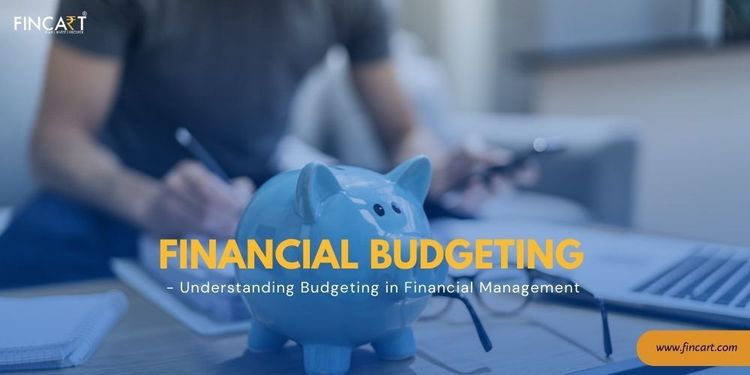Table of Contents
ToggleHave you ever wondered why you are broke by the end of the month? This is a phase that the majority of millennials go through. It begs the question, why does this happen?
The reason is not following the process of budgeting. A budget is nothing but keeping track of your monthly expenses and segregating it for different purposes. The lack of financial management is what leaves you broke by month-end.
In this blog, you will understand the ABC of budgeting in financial planning & how it will benefit you.
What is budgeting?
Budgeting is the process of keeping track of your income and expenses and creating a spending plan as a result. With the right cash flow management, you will be able to stay within your budget and manage your cash flow effectively. It can help you identify areas where you may be overspending and be able to adjust your spending habits accordingly if necessary. What is financial planning and how does it support financial planning you may ask? Stay tuned with us throughout the entire blog!
What is financial budgeting?
Financial budgeting is the process of financial planning and managing your income, expenses, and savings to achieve your financial goals. It involves creating a detailed plan that outlines how you will allocate your financial resources to cover your expenses, save for the future, and potentially invest for growth. Financial planning and budgeting typically includes the following key elements:
- Income
- Expenses
- Savings and Investments
- Financial Goals
- Budgeting Tools
- Monitoring and Adjusting
- Emergency Fund
- Debt Management
Financial budgeting provides a structured approach to managing your money, ensuring that you are aware of your financial inflows and outflows and making intentional decisions about how to allocate your resources. It empowers you to make informed financial choices, helps you track progress toward your goals, and promotes financial stability and well-being.
Types of budgeting
There are several types of budgeting methods that you can use to manage your finances and allocate resources effectively. Here are some commonly used types of budgeting:
1. The Envelope System
This is a traditional system that is widely used in terms of maintaining a physical budget a.k. keeping cash. Under this system, you start by understanding how much amount of money you end up spending in a month. Secondly, break down your expenses into categories like lifestyle expenses (shopping, entertainment), savings, and necessary expenses (rent, electricity, etc). Now generally, 50% of your income should go under your necessary expenses; 30% under your lifestyle expenses & 20% under your saving envelope.
The rule of thumb is that whatever happens, you can’t use the next envelope once you end up spending the other envelopes. Those who prefer to use cash and stay strict with their spending might find the envelope budgeting system useful.
2. Zero-based Budgeting
This type of budgeting is kind of similar to the envelope one but comes with certain key differences. Here, you don’t need the envelopes to track your monthly expenditure nor you are required to keep the cash.
Managing your budget and tracking spending categories will take time, and you’ll need a plan for what to do with money left over (savings, for example). Overspending in one category means you have to cut back on that area until the next month or take money from another area.
If you’re looking for a detailed approach to managing your money and want to know exactly where your money is going, a zero-based budget is a good option for you. Credit card users can also benefit from this approach.
3. The 50/30/20 Plan
The most simple & widely used budgeting approach is the 50/30/20 method.
The 50/30/20 plan only requires you to track three categories of spending: necessary expenses, discretionary expenses, and financial goals. The plan allocates 50% of your expenses to necessities, 30% to lifestyle, and 20% to financial goals such as paying off debt, saving, and investing.
However, you can come up with your ratios based on your current situation and goals. If you have a lot of debt or a small emergency fund, putting more than 20% of your budget toward those goals while reducing discretionary spending may make sense.
You may find this budgeting plan useful if you feel that too many budgeting categories will be overwhelming.
Also Read:- Are Budgeting And Financial Planning The Same?
Looking for a Financial Advisor?
Connect with Fincart for personalized financial advisory services and achieve your financial goals with confidence.
Components of a Budget
When it comes to personal finances, a budget consists of specific components that help individuals manage their income, expenses, and savings effectively.
A personal budget management should include the following components:
- Fixed Expenses:
Fixed expenses are recurring expenses that remain relatively constant from month to month. They include items like rent or mortgage payments, loan repayments, insurance premiums, utilities (e.g., electricity, water, internet), and subscription services (e.g., streaming platforms, gym membership).
- Variable Expenses:
Variable expenses are costs that fluctuate from month to month and depend on your consumption or choices. They can include groceries, dining out, entertainment, transportation, clothing, personal care items, and discretionary spending.
- Savings and Investments:
This component focuses on allocating a portion of your income towards savings and investments. It includes contributions to emergency funds, investment opportunities, or other long-term financial goals.
- Debt Repayment:
If you have any outstanding debts, this component involves budgeting for debt repayment. It includes payments toward credit card balances, student loans, car loans, personal loans, or any other debts you need to pay off systematically.
- Financial Goals:
Personal budgets should incorporate specific financial goals that you want to achieve. These can include saving for a down payment on a house, paying off a certain amount of debt, funding a vacation, or building an education fund. Clearly defining and allocating resources towards these goals helps track progress and stay motivated.
- Discretionary Spending:
Discretionary spending refers to expenses that are not essential but are for personal enjoyment or non-essential items. This category can include hobbies, entertainment, travel, dining out, gifts, and other non-essential purchases. It’s important to allocate an appropriate portion of your budget for discretionary spending while maintaining a balance with other financial priorities.
- Contingency Fund:
A contingency fund or emergency fund is a crucial component of personal finance. It involves setting aside money to handle unexpected expenses, such as medical emergencies, home repairs, or job loss. Having a contingency fund provides financial security and helps avoid taking on debt during emergencies.
Also Read: How to Achieve Financial Independence Early?
How to create an effective budget
Here’s a step-by-step guide on how to create an effective budget:
Decide what your financial goals are: Start by defining your financial goals. Identify what you want to achieve in the short term (e.g., paying off debt) and the long term (e.g., saving for retirement, or buying a house). Having specific goals will provide focus and guide your budgeting decisions.
To determine your income, add up all the sources of income you receive each month. Include salary, wages, bonuses, self-employment income, rental income, and any other sources of money you receive regularly. This will serve as the basis for your budget.
Keep Track of Your Expenses: Take a close look at your spending habits by tracking your expenses for a month or two. Divide your expenses into fixed (e.g., rent, loan payments) and variable (e.g., groceries, entertainment). You will be able to identify where your money is going and where you may need to make changes.
Establish Spending Categories: Create specific categories for your expenses based on your tracking. Some common categories include housing, transportation, utilities, groceries, debt payments, entertainment, savings, and investments. Tailor the categories to fit your spending patterns and financial goals.
Allocate Income to Categories: Assign a portion of your income to each spending category based on your priorities and needs. Start with essential expenses like housing, utilities, and debt payments, and then allocate funds to other categories accordingly. Ensure that the total allocated amount does not exceed your total income.
Make savings and debt repayment a priority: Save and repay debt with a portion of your income. Aim to save at least 10-20% of your income for short-term and long-term goals. Set aside a specific amount for debt repayment to accelerate paying off any outstanding debts.
Track your actual spending against your budget and review it regularly. This will help you identify areas where you’re overspending or underspending and make necessary adjustments. Be flexible and make changes as needed to ensure your budget remains realistic and aligned with your financial goals.
Consult a professional if Needed: If you find budgeting challenging or have complex financial situations, consider seeking help from a financial advisor or planner. They can provide guidance, offer personalized advice, and help you create a more comprehensive and effective budget.
Benefits of financial budgeting?
Financial Control:
Budgeting provides a clear overview of your income and expenses, giving you better control over your finances. It helps you track where your money is coming from and where it’s going, allowing you to make informed decisions about spending and saving.
Improved Money Management:
Budgeting enables you to allocate your income effectively, ensuring that you meet your financial obligations and prioritize your financial goals. It helps prevent overspending, encourages saving, and reduces the risk of falling into debt.
Goal Achievement:
By creating a budget, you can set specific financial goals and allocate funds toward them. Whether it’s saving for a down payment on a house, paying off debt, or building an emergency fund, budgeting provides a roadmap for achieving your objectives and staying on track.
Reduced Financial Stress:
A well-planned budget helps alleviate financial stress by providing a sense of control and security. It eliminates the worry of not knowing where your money is going or how you’ll cover your expenses. Budgeting allows you to plan for future expenses, emergencies, and unexpected events, providing peace of mind.
Debt Management:
Budgeting helps you tackle and manage debt effectively. By allocating funds specifically for debt repayment, you can develop a structured approach to pay off your debts over time. It ensures that debt obligations are met, and you can make progress toward becoming debt-free.
Improved Saving Habits:
Budgeting encourages regular saving by making it a priority in your financial plan. It helps you identify areas where you can cut back on expenses and allocate those savings toward your financial goals. Budgeting also helps establish an emergency fund, ensuring you have funds available for unexpected expenses.
Financial Adaptability:
With a budget in place, you can respond more effectively to financial changes and fluctuations. Whether it’s a job loss, a decrease in income, or an unexpected expense, budgeting helps you adjust your spending and prioritize your financial commitments accordingly.
Tips for successful financial budgeting
For successful budgeting, follow these 6 tips:
- Create a spending plan
- Separate your needs from your wants
- Do not fully rely on credit cards/Limit your debt
- Write down/keep track of your every expense, whether it costs less or more!
- Plan for irregular expenses beforehand
- Review your budget monthly and make the necessary adjustments
Conclusion:
Budgeting is important because it provides a clear roadmap for managing your finances, allowing you to track income, control expenses, and prioritize savings, ultimately helping you achieve your financial goals. You can reduce financial stress, build an emergency fund, plan for the future, and make more informed financial decisions, leading to increased financial stability and peace of mind.
FAQs
What is financial savings management?
Financial savings management involves planning, tracking, and optimizing how money is saved to achieve short-term and long-term financial goals. It ensures funds are set aside systematically for emergencies, investments, or future expenses.
What is budgeting in finance?
Budgeting in finance is the process of creating a plan to manage income and expenses. It helps individuals or organizations allocate resources efficiently and avoid overspending, ensuring financial stability.
What is budgeting in management?
Budgeting in management refers to setting financial goals, estimating future expenses, and allocating resources within an organization. It serves as a tool for controlling costs and aligning financial activities with strategic objectives.
What is the difference between budgeting and financial planning?
Budgeting focuses on short-term financial management, tracking income and expenses to maintain control over daily finances. Financial planning, on the other hand, takes a long-term approach, setting goals for wealth building, investments, and retirement planning.




